


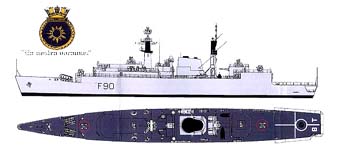 White
Ensign Models 1/350 Type 22 frigate, HMS Brilliant
White
Ensign Models 1/350 Type 22 frigate, HMS Brilliant
Price : £138.99
by Mike Dunn
Introduction
HMS Brilliant was the third of the Type 22 frigates commissioned by the Royal Navy. She served long and well, most notably in the Falklands War, claiming several aircraft 'kills'. After serving 19 years, she was sold to the Brazilian Navy in 1997. It's very nice to see a kit of this class of ship, as it has been sadly neglected by the mainstream manufacturers.
The box is a long rectangular one, with WEM's information, a colour photo of Brilliant and her badge, and a potted history of the ship on the outside. On opening up, you see two bubble-wrapped packages and three envelopes.
The kit
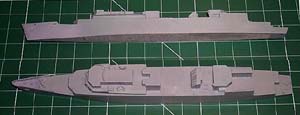 On
opening the larger of the two bubble-wraps, you get to the hull. As this
particular kit is waterline, there is only one piece here; I understand
that the full-hull kit has two pieces. On examining this hull, two things
are immediately obvious. The first is the near-total lack of areas needing
attention, and the second is how good this hull is. The only problems
seen in this example are four tiny holes on the starboard bow, and three
bubbles on the underside of the hull. Well, the holes will fill in 5 seconds,
and the bubbles? As this is waterline, you can forget all about them,
especially as they are away from the edge.
On
opening the larger of the two bubble-wraps, you get to the hull. As this
particular kit is waterline, there is only one piece here; I understand
that the full-hull kit has two pieces. On examining this hull, two things
are immediately obvious. The first is the near-total lack of areas needing
attention, and the second is how good this hull is. The only problems
seen in this example are four tiny holes on the starboard bow, and three
bubbles on the underside of the hull. Well, the holes will fill in 5 seconds,
and the bubbles? As this is waterline, you can forget all about them,
especially as they are away from the edge.
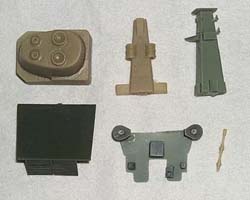 |
|
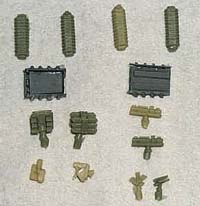 |
|
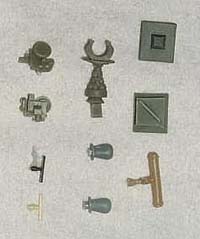 |
|
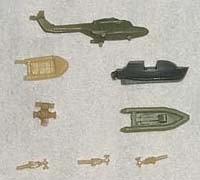 |
|
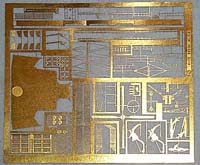 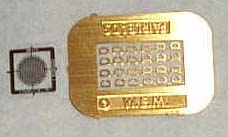 |
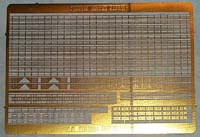 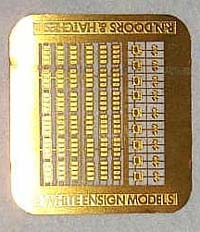 |
There is a reasonable amount of detail on the hull, enough to produce a great-looking vessel when completed with the other detailing parts provided. I understand that this was one of the master maker's (Peter Hall) early models, and that he now adds more details to the latest masters he makes - all I can say to this is they must be crammed with detail! This hull is approx. 15" overall length.
Moving to the second bubble-wrap, you get one large bag with numerous smaller ones inside. This is where all of the other resin detailing parts are, ranging from the weapons fit in one bag, to the masts and stack in another, and the ships boats in yet another. On examining each of these ten bags of parts, the same feeling seen on the hull comes back. These parts are extremely well-detailed, and very well-cast. Indeed, I can find flashing on one piece of the entire kit, and that is so minor it can be cleaned off in seconds. WEM's casters are to be congratulated on their fine work.Looking at the envelopes, we get two containing photo-etch sheets, and one full of the instructions. The first PE envelope holds three sheets - a large general Royal Navy sheet, with generic rails etc., as well as the flight-deck grid used for the Lynx helicopter to 'lock down' on landing, and a fret of fairleads. These are well-done, especially the landing grid - the mesh is extremely fine. These smaller sheets are in their own plastic bags as well.
The second envelope holds a small fret of hatches and doors, with a larger fret of the specific Type 22 PE parts. As with the other three frets, these two are finely detailed and well done.
Moving to the instructions, here you get eight sheets of A4, mostly double-sided. The first sheet has more history on the vessel, with some specifications, and the usual warning about resin. The reverse details exactly what is on the specific Type 22 PE fret, and is very clear - if you mix any parts up, it's your own fault for not checking! The next sheet shows what is on the other four PE frets, and the locations on the hull of the doors and hatches. Again, you can't fault the instructions for any mistakes you may make! The reverse of this sheet is where the assembly instructions begin, and carry on for five more sides of paper. They are well laid-out, and have clear diagrams explaining locations, how to do the PE, etc. The last side is a top and side view of the vessel, with a parts locator on - if you do get mixed up over what goes where, this will clear things up.
The next sheet is a colour guide for the painting, and is very comprehensive. The last sheet is a faulty part report - not that I expect, on first looks, to be using it!
Conclusion
So, is this worth the money? Well, the fact that it is a Type 22 kit will endear it to all the Royal Navy modellers - it will be popular just for that alone. What makes this extra-special is the time and care taken by the master mould-builder, by the casters, and by the author of the instructions. And one of these would make this a better kit - all three make it wonderful. Yes, it's expensive - and yes, it's worth every penny. This is the first resin kit I've bought from WEM, and the first in 1/350 scale. It won't be the last. I look forward to building her.

Previous: Contents








